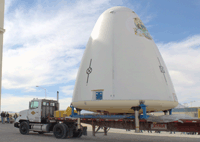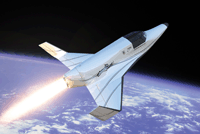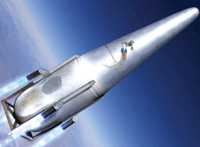Space Tourism: The competition
 |
|---|
© Blue Origin |
In 2005 Flight International reported that Amazon.com founder Jeff Bezos's Blue Origin could fly in 2008. A 2006 US Federal Aviation Administration assessment described his New Shepard rocket as a three-person, crew-carrying 15m (49ft)-tall rocket with flights in 2010.Very secretive flight testing was to begin in 2006, but Blue Origin has revealed only its 13 November 2007 Goddard technology demonstrator launch. In October 2008 the company said it expected unmanned commercial science experiment flights in 2011 and manned flights in 2012.
 |
|---|
© Xcor Aerospace |
Announcing its first customer - Danish-born London financier Per Wimmer - in December 2008, Xcor Aerospace unveiled the rocket-powered aircraft concept it calls Lynx in March of that year. Based at Mojave air and spaceport in California, the company's Mark 1 Lynx will go to 61km (37.8miles) while Mark 2 has an apogee of 110km. Xcor has estimated that in total the project will cost $17 million. Undisclosed private investment is helping develop and test-fire its 5K18 engine. Xcor is also exploring potential military applications for suborbital technology.
 |
|---|
© Armadillo Aerospace |
A prototype vertical take-off and landing (VTOL) vehicle could be built this year by Armadillo Aerospace, but funding is now more limited after the collapse of the 2008 Rocket Racing, Armadillo and New Mexico government announcement. It set out a joint venture to deliver a reusable VTOL vehicle, launch site and financing for a third party to operate a $100,000-a-seat service. Armadillo's owner, video game entrepreneur John Carmack, has invested more than$4 millionso far. Last year Armadillo won a $350,000 Northrop Grumman Lunar Lander Challenge prize.
 |
|---|
© EADS Astrium |
There are a number of contenders that have fallen behind. After spending $24 million on development including a $15 million Oklahoma tax credit- Rocketplane is performing computer-based analysis and seeking funds. In 2006 US orbital tourism provider Space Adventures unveiled a suborbital deal with Russian industry and government. To have been launched from Singapore and Dubai, it ended after one year. EADS Astrium's space jet, unveiled in 2007, has had its development slowed after shortfalls in raising funds to meet its estimated €1 billion($1.34 billion) cost.
Source: Flight International


























